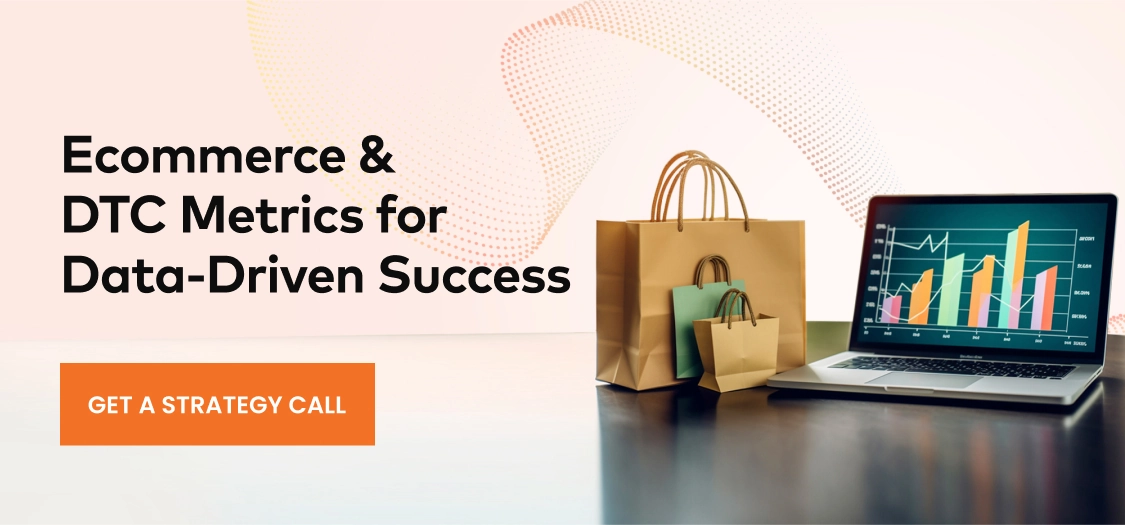The Ultimate Guide E-Commerce & DTC Metrics
A DTC brand’s success can be measured by its revenue and profit but there are certain metrics that help a brand to understand and go deeper into the why’s and what’s of the growth that’s happening throughout.
To understand how eCommerce has transformed marketing and an ecommerce or DTC business’ health and performance, we need to have some metrics in place.From monthly recurring revenue (MRR) to customer lifetime value (LTV), we need to keep a track of some of the most important metrics which will help you in understanding the cost efficiency of your business and identify the areas where you need to improve. Here's a DTC Glossary you ought to be thorough with if you own a DTC business.
Since the inception of Saffron Edge as the best Ecommerce SEO Services agency we have interacted with hundreds of DTC founders and have tried to gauge the kind of challenges faced by them in the areas of data and consumers. We have helped many fast growing DTC brands to grow and today we put down an article for you also to understand where you stand in terms of your business’ performance. To review your brand's performance, you can also download our DTC Metrics Toolkit or opt for our DTC Services For Digital eCommerce. Our ultimate SEO marketing guide for your DTC Brand is a comprehensive resource designed to help you optimize your online presence and achieve greater visibility. So let’s deep dive into which metrics you should be more interested in as per your brand requirement and learn about Conversion Rate Optimization for DTC eCommerce Services.
Here's How Can Big Data & AI Help eCommerce Brands! Big data and AI have revolutionized eCommerce, offering significant opportunities for brands to enhance their operations and drive growth. At Saffron Edge, we harness the power of big data and AI to empower eCommerce brands with actionable insights and intelligent automation. This empowers eCommerce brands to optimize scalable route-to-market with growth marketing strategies, personalize customer experiences, streamline operations, and improve overall business performance. With Saffron Edge' s expertise in big data and AI along with its DTC Performance Marketing, eCommerce brands can unlock their full potential and stay ahead in the competitive online marketplace.

A. Business Economics:
For DTC marketing, the first and foremost metric that should be looked into is the business economics referring to the financial indicators being used to measure the performance and growth of your business. To measure the revenue and sales being generated, we have the following metrics:
1. Customer Acquisition Cost (CAC):
CAC lets you know the cost to acquire a customer including all the costs of advertising to that customer. As a brand builds its credibility and visibility, CAC ideally reduces. Hence, it is a great KPI to set targets for.
CAC=(Cost of Sales + Cost of Marketing)/New Customers Acquired
2. Cost Per Acquisition (CPA):
CPA is the cost it takes to get one customer onboard from a campaign on a channel. It is advisable that your CPA is lower for that particular channel.
CPA=Total Campaign Cost/Conversions
B. Brand Metrics:

You need to understand how good is the brand recall and how well has your brand been discovered are some of the important goals you can assess from these metrics:
1. Social Listening:
This is to track how frequently your DTC brand is being talked about on social media. This can be elaborated as to what platforms have the most mentions, how is your target audience like. You can also know if the mentions are positive or negative.
- Reach of mentions:The reach of your mention will be higher when your account has a higher number of followers than having just a hundred followers.
- Sentiment score:This helps gauging the overall public sentiment around your brand and products which will in turn help you in understanding potential issues in your offerings based on your consumer needs.
Net sentiment score=Positive conversation - Negative conversation
- Net Promoter Score: This metric helps you in understanding how likely is your consumer to recommend your product or services.
NPS=% of promoters(customers who would talk good about you) - % of detractors(customers who won’t talk good about you)
2. Branded Search Volume:
Another metric to understand how much awareness your brand has is to evaluate branded search volume. This means how many people search for your brand name and associated keywords. This can be measured by using SEO tools like Semrush, Ahrefs, and Moz or opting for DTC SEO services.
3. Backlink profiles:
You can check the performance of the links to your website on other domains. This can tell you how popular your brand is
4. Social Share of Voice:
SOV is the measurement of your brand’s visibility as compared to your competitors in the market with respect to marketing, advertising and social media. This can help you in allocating your marketing budget efficiently. This can be measured either manually or by social listening tools.
SOV=Number of mentions of your brand/total number of brand mentions(yours + your competitors) X 100
C. Organic Search Engine:

This gives you a good idea of the visibility and performance of your website in organic search results and also the audience on what will be their next step. There are many companies offering direct-to-consumer (DTC) organic marketing service, which can help businesses measure organic visibility and gain more traffic.
1. Organic CTR:
You can get to know how many people come to your website by looking at your organic search results with this metric. For example, if 500 people see your website in organic search and 100 people click on it, then your CTR is 20%.
2. Exit Rate:
This metric lets you know the last pages your user visited before they quit your website. If some specific pages have a higher number of exit rate, this means your content of those pages is not good enough to keep them hooked to your website.
Exit rate=No. of exits from a page/No. of page views
3. Page Load Time:
The final and the most important metric in SEO marketing is the page loading time which means how much time is your page taking to load. Most of the time this is where you lose your users if the page takes longer than usual.
D. Paid Advertising:

Do you know if your paid ad campaigns are profitable or not?
1. Conversion Rate:
This metric is usually the one which most marketers care about. That is because it lets you know how well your ad and landing page work together to complete an action for the user.Conversion Rate=(No. of conversions/No. Of sessions)X100
2. Cost Per Conversion:
The best deciding factor for a campaign to perform good or bad is CPC. If your CPC is higher than the money made off the actual conversion, then this means you’re spending more on obtaining a customer than what the customer is actually worth. And this is a loss for you.
CPC = (Total cost of ads/No. Of conversions)
3. Return on Ad Spend:
This is Return on Ad Spend and it measures the revenue generated for every buck spent on advertising. A high ROAS means your advertising campaign is generating significant revenue compared to your advertising cost.
ROAS=Gross revenue from ad campaign/Cost of as campaign
Have you ever wondered: Why ROAS Does Not Equate to Long-term Business?While Return on Ad Spend (ROAS) is an important metric that measures the revenue generated from advertising expenses, it's crucial to recognize that ROAS alone does not guarantee long-term business success. Factors such as customer lifetime value, brand reputation, customer loyalty, and overall business growth should also be considered to ensure sustainable and enduring success in the competitive marketplace.
E. Social Media:
A DTC brand needs to have a strong social media presence and that is one of the most important platforms where your brand can connect to its respective audience. Most DTC brands are even using social commerce for their sales.
a) Content:
Social media works best with a content strategy and to measure if that’s working for you or not, you need to check these metrics:
Average Engagement Rate:How many people react to your content is your Engagement and tracking it would let you identify which type of content will work best for your brand. How to measure it?
AER: (Total engagements/number of posts) X 100
b). Customer Retention:
It is important to get new visitors but it is even more important to retain your old customers. This will let you craft a marketing campaign that is able to yield more engagement.
CRR=(Customers at the end of the period)-(New customers acquired)/Customers at the start of the period
4. Customer Lifetime Value:
CLV is the profit margin a DTC brand expects to earn over the entirety of their business relationship with the average customer. It takes into account all their orders ever placed and used. It is a good metric to size up customer satisfaction, loyalty and the viability of a brand. CLV is long term, repeating the benefits of better ROI and unit economics.
Customer Value=Avg value of sales X Avg number of transactions
CLV=Customer value X Avg customer life span
F. Retaining the customers:
Believe it or not but abandoned products in the cart lead to brands losing their precious customers and also revenue. This usually is the case when products on your website are not promoted strategically. The listing images and banners aren’t enticing enough for your potential customer. Another big reason is the user experience while checking out. Then there are customers who keep coming back to you like a loyal customer. These are precious to us.
1. Customer Retention Rate:
The percentage of existing customers who will stay with you after a certain period of time is the customer retention rate. For DTC brands, this metric will help in understanding what brings back our customers to us whether it is the 1-day delivery, the pricing, the promotional adverts or the adverts.
CRR=(Customers at the end of the period)-(New customers acquired)/Customers at the start of the period
2. Cart Abandonment Rate:
A high cart abandonment rate means that either your sales funnel isn’t working as expected or your store isn’t well optimized for user experience.
CAR: {1- (No. of completed transactions) } /no. Of initiated transactions
G. Budgeting:
You need to have a marketing budget in place by assessing your previous marketing tactics and how they performed in the previous month. DTC brand marketers tend to spend more on retention and retargeting. According to a report by Measured, DTC marketers are facing challenges in mining insights from analytics. Therefore, they end up tying media to outcomes. DTC marketers are estimated to allocate their budgets as 37.2% share to prospecting, 30% to retargeting and 32.8% to retention. So ideally, your marketing budget should be like:
- New business to allocate 12-20% of their revenue to marketing
- Companies older than five years to allocate 6-12% of their revenue to marketing
- B2B companies to allocate 7-8% of their revenue
- B2C to allocate 9% of their revenue
H. Return to Origin (RTO):
RTO is a major cost incurrence on an Ecommerce business. It is the cost incurred when a package hasn’t been delivered to the buyer and is returned to the seller. For some Ecommerce businesses, RTO can go upto 30% if not kept in check. Certain ways you can keep a check on this and reduce it are:
- By targeting audience based on purchasing capacity and in tier 1 and tier 2 cities and lastly by running discounts on prepaid orders.
- At operation level, you need to stay with the customer at every touchpoint. You need to check their information like their address and pincode and make calls to the customer in order to qualify the order and dispatch them.
- At shipping level, you need to let the customer know about the shipping and tracking details of their package. A contact number of the delivery agent so that the customer is able to receive the order.
RTO= { (No. of orders not accepted+Cancellations+Orders not delivered+Returns after delivery)/Total no. of orders }
I. Marketplaces:
1. Amazon
Amazon Brand Metrics gives you an opportunity to quantify every stage of a buyer’s journey on Amazon. It measures the number of actual on-Amazon shopper engagements. It measures the impact of your upper and mid funnel tactics and sees how they contribute to shoppers moving through the buyer journey. Key metrics for D2C businesseson Amazon encompass factors such as sales performance, customer reviews, seller ratings, product rankings, and advertising campaign effectiveness. Some of the metrics to keep in mind forAmazon marketplace:
- Conversion Rate:Percentage of the visitors to your product listing who make a purchase. By keeping a track of this metric usingConversion Rate OptimizationDTC Tech Commerce Services, you can identify the opportunities to improve the effectiveness of your product listing and sales.
- Customer Reviews and Ratings:These are indicators of the quality of the product and customer satisfaction by the product. By tracking your reviews, you can identify the areas of improvement.
2. Walmart
To accomplish this, it is essential to establish some requirements that all sellers must adhere to in order to sign an agreement. Walmart refers to these metrics as "Seller Performance Standards," and they each measure distinct values based on a percentage of orders or vendor response rate. Some of the metrics to keep in mind for brands on Walmart:
- 90 day Order Defect Rate:Walmart first calculates your ODR by dividing the total number of defective orders within the same purchase time by the number of purchases. Your ODR must be 2% or less to be in excellent standing with Walmart.
- Cancellation Rate:The average for Walmart is less than 2% of canceled purchases. Order cancellation from Walmart after it has been delivered raises the cost. Your ranking improves as the rate decreases.
Cancellation rate=(No. of orders canceled/No. Of transactions)X100
- On time Delivery Date:The Walmart benchmark is greater than 95%. The Expected Delivery Date, which is based on the order cutoff time, completion lag time, and transit time, must be met for all deliveries to take place. On this page, best methods for on-time delivery are laid out.
3. India's Myntra
Myntra is an online fashion and lifestyle marketplace, and there are several metrics that can be used to measure the performance of its business. Here are a few examples:
- Gross Merchandise Value (GMV):GMV is the total value of goods sold on Myntra's platform. It is the most important metric to measure the business potential of Myntra and its revenue generation.
GMV = Sales price of goods X No. of goods sold
- Customer Acquisition Cost (CAC):As discussed earlier, CAC is the cost of acquiring new customers. By measuring CAC, Myntra can evaluate the efficiency of its marketing strategies and identify areas for improvement.
CAC=(Cost of Sales + Cost of Marketing)/New Customers Acquired
- Conversion Rate:CR is the measurement of the visitors Myntra gets on its platform to make a purchase. By understanding this metric, Myntra can identify the areas where the user experience can be improved to have better sales.
Conversion Rate=No. of conversions/Total no. of visitors
- Average Order Value (AOV):AOV is the average amount spent by customers on each order. By monitoring AOV, Myntra can identify opportunities to upsell or cross-sell products and increase revenue.
- Return on Investment (ROI):ROI measures the return on investment for Myntra's marketing and advertising efforts. By measuring ROI, Myntra can evaluate the effectiveness of its campaigns and make adjustments as needed to improve their performance.
ROI = (Sales growth - marketing cost)/marketing cost
4. Australia's Myer
This is a large Australian department store chain that also operates a marketplace. Here are some metrics that can be used to measure the performance of Myer's marketplace:
- Gross Merchandise Value (GMV):GMV is the total value of goods sold on Myer's marketplace. It is a key metric for measuring the scale of the business and its revenue potential.
GMV = Sales price of goods X No. of goods sold
- Seller Engagement:This metric measures the level of engagement and participation of the sellers on Myer's marketplace. It includes factors such as the number of active sellers, the number of products listed, and the quality of product information.
- Customer Acquisition Cost (CAC):CAC is the cost of acquiring a new customer. By measuring CAC, Myer can evaluate the efficiency of its marketing strategies and identify areas for improvement.
CAC=(Cost of Sales + Cost of Marketing)/New Customers Acquired
- Conversion Rate: Conversion rate measures the percentage of visitors to Myer's marketplace who make a purchase. By monitoring this metric, Myer can identify areas where the user experience can be improved to increase sales.
Conversion Rate = No. of conversions/Total no. of visitors - Average Order Value (AOV):AOV is the average amount spent by customers on each order. By monitoring AOV, Myer can identify opportunities to upsell or cross-sell products and increase revenue.
- Customer Satisfaction:This metric measures the level of customer satisfaction with Myer's marketplace. It includes factors such as product quality, shipping times, and customer service.
- Return on Investment (ROI):ROI measures the return on investment for Myer's marketing and advertising efforts. By measuring ROI, Myer can evaluate the effectiveness of its campaigns and make adjustments as needed to improve their performance.
ROI = (Sales growth - marketing cost)/marketing cost
J. Logistics:
Every day, the logistics sector generates enormous quantities of data from activities like picking and packing, shipping orders, and warehousing. Having said that, organizations that use logistics analytics solutions to raise their performance will be successful in the long term. Some of the logistics metrics to look into for your brand’s operational processes are:
- Shipping time:Look out for potential problems during the order fulfillment procedure
- Order Accuracy:Keep track of event volume
- Delivery:Keep a close eye on your typical delivery period
- Costs of Transportation:Examine all expenses from placing the purchase to delivery
- Inventory to sales ratio:Identify a potential overstock
- Inventory turnover:Track the number of times your total inventory is used up
K. Website and Application Performance
94% of chief marketing officers (CMOs) think analytics will help them achieve their objectives, but uptake has been slow. In reality, only 15–25% of businesses use data and Google Analytics to inform marketing and operational choices. These metrics will assist you in not only improving your website but also in turning visitors into paying clients.
1. UX-UI:
These KPIs can help identify areas of strength and weakness in the website's UX-UI design and guide efforts to improve the overall user experience:
- Bounce Rate:This measures the percentage of users who leave a website after only viewing one page. A higher bounce rate can indicate poor website design or irrelevant content.
Bounce rate=(No. of single page sessions/No. Of total page sessions)X100
- Conversion Rate:This measures the percentage of website visitors who complete a desired action, such as making a purchase or filling out a form. A higher conversion rate is generally preferred.
CR=(No. of conversions/No. of visitors)X100
- Page Load Time:This measures how long it takes for a web page to fully load in a user's browser. A faster page load time is generally preferred, as slower load times can result in a negative user experience and lower search engine rankings.
- Pages viewed per session:This is a metric that measures the average number of pages viewed by a user during a single visit to a website. It is a useful metric to track because it can give insight into user engagement and the quality of the website's content.
Pages viewed per session = (Total pages viewed/Total no. of sessions)X100
- Mobile Responsiveness:This measures how well a website performs on mobile devices. With more and more people accessing websites on their smartphones and tablets, it's important for a website to be mobile-friendly.
2. Creative Design:
Website designers and stakeholders can make data-driven decisions about the website's visual components, enhance the user experience, and eventually boost the website' s performance by keeping an eye on these creative design KPIs:
- Visual appeal:This gauges how appealing a website is on the whole, taking into account the use of color, font, imagery, and general design aesthetic.
- Brand Consistency:The degree to which the website's design adheres to the brand' s visual identity and standards is referred to as brand consistency.
- User engagement:This gauges how visitors connect with the website's visual components, such as scrolling, clicking, and site exploration.
- Accessibility:This gauges how well the website's visual layout suits visitors with disabilities, taking into account factors like font size, color contrast, and other aesthetic elements.
L. Internal Review:
Internal reviews in a DTC business can have a significant impact on the functioning of the business. This is to improve the customer experience, how the business functions and reduce costs and ensure compliance. Some of the metrics which need to be kept in mind are:
- Quality control:Internal processes and product quality can be the areas that need improvement to improve customer satisfaction. This can help the business to reduce the number of returns, improve customer loyalty and increase revenue.
- Limited Resources:This could lead to incomplete tasks and inefficient delivery of the task. Not only RTO but also Order defect rate and cancellation rate can increase because of limited resources who are unable to multi-task in the business.
- Customer Service:Lesser number of employees can be challenging in providing high quality customer service. However, with the right training and support, employees can still provide excellent customer service and help in building loyalty.
It's time to maximizing DTC growth potential through the implementation of digital strategies by Saffron Edge. As Direct-to-Consumer (DTC) brands continue to grow in popularity, it' s becoming more challenging to stand out from the crowd in the digital marketing landscape. This is where growth hacking comes into play.Growth hacking is aremarketing strategythat focuses on finding creative, cost-effective, and scalable ways to reach new audiences and drive growth.Understanding the significance ofDTC Marketing for fashion brands' is crucial for fashion businesses looking to thrive in today' s digital landscape.One of the most effective growth hacking tactics for DTC brands is to cater to untapped audiences.
This means targeting demographics or niches that are often overlooked or underserved by traditional marketing efforts. At Saffron Edge, we have been able to tap on the niche of transgenders and LGBTQ as a very important audience segment for a fashion brand. And it has been able to get us a high number of leads. Another category which we have been able to cater to is the CBD industry. The audience is very niche there that the growth hacks are mandatory because your generic google ads won’t work here.
Another important aspect of growth hacking is experimentation. For DTC brands, this might mean experimenting with social media platforms or influencers that they haven't worked with before, or trying out unconventional marketing channels like podcasts or virtual events.DTC brands can discover innovative avenues to reach their audience and fuel growth by leveraging professional Direct-to-consumer marketplace services, Direct-to-consumer (DTC) Paid Marketing Services, DTC Performance marketing, Digital eCommerce Services, and implementing diverse growth hacking tactics.
The key is to stay agile and flexible, and be willing to pivot or adjust strategies based on the results of each experiment. As your DTC business grows, it keeps becoming difficult to measure each metric and go in depth with the analysis of it. The analysis of it will help in assessing the health and performance of your business. We at Saffron Edge have our growth hacks which help you to excel in your category and hone your capabilities which have been unexplored as of now.
What our customers say about us


















































